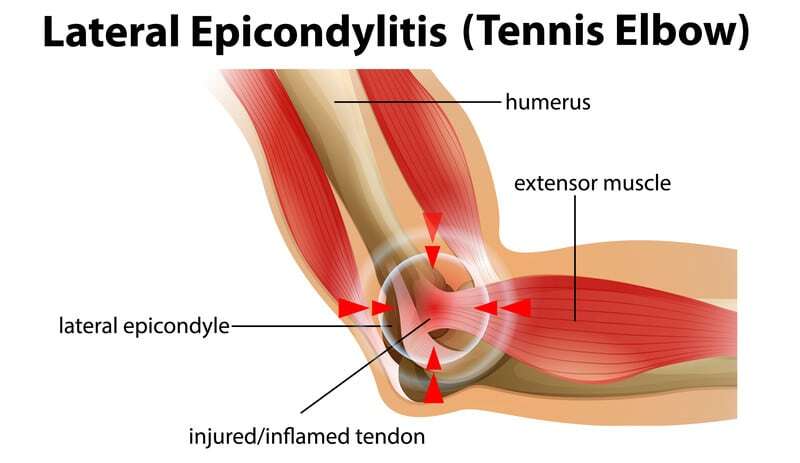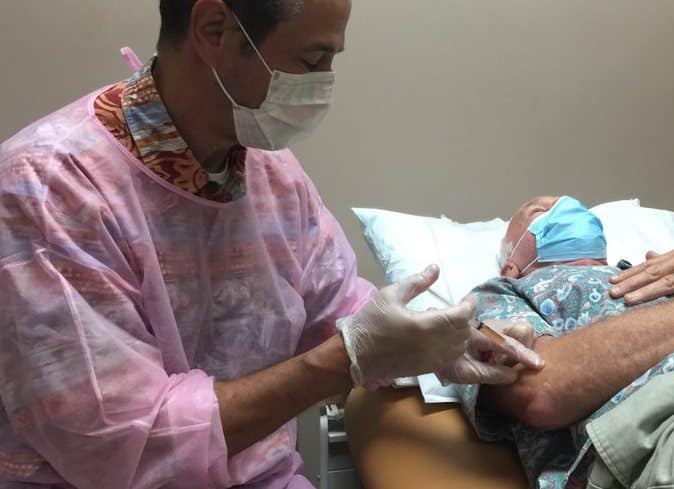Marc Darrow MD, JD.
We will often see patients who have lingering elbow pain. They continue to receive and remedy themselves with traditional “conservative” treatments that include resting, icing, anti-inflammatory medications, Kinesio tape and various other health care provided treatments including physical therapy, massage, cortisone injections and even acupuncture. While some will respond to these treatments the patients who come into our office have not. They have been scheduled for one of the many surgical procedures often suggested for treatment of lateral epicondylitis. Most will be recommended to a debridement, the removal of tissue “too far gone,” to be saved. For many, removing tissue may not be their optimal way way to go. These people will reach out to us to discuss the realistic surgical alternatives we can offer. In this report we will discuss Platelet Rich Plasma Therapy and bone marrow stem cell therapy as well as look at some new research on tennis elbow surgery.

Tennis elbow not just in tennis, but in office workers and laborers
There is a great probability that the people reading this article have been diagnosed with tennis elbow that have never played tennis in their life. We have seen patients with tennis elbow who were carpenters, rock climbers, office workers, landscapers, golfers, and more. Many never having picked up a racquet.
- Tennis Elbow (lateral epicondylitis) is a term for severe elbow tendonitis, or an inflammation, soreness, or pain on the outside (lateral) part of the upper arm near the elbow.
- The cause is usually common extensor tendinosis or a partial tear in the tendon fibers, which connect muscle to the bone. Of the tendinopathies, the traditional term tendinitis refers to the acute (recent) inflammatory stage of tendon injury, while the new term, tendinosis refers to the chronic injury when inflammatory cells are no longer seen, but the tendon is worn.
- Symptoms include elbow pain that gradually worsens and radiates outside of the elbow to the forearm and to the back of the hand.
While many of these people have never picked up a racquet, they usually have picked up a shopping cart filled with elbow tapes, braces, and sleeves that they hope will help them.
Patients with tennis elbow may not respond to the conventional treatments of “wait, rest, and medicate for pain relief.” For many patients, this slow track to healing is not on their schedule. Most patients prefer getting on with their lives by fast-forwarding the healing process. So they try many things. Some work. Some don’t.
Why tape, sleeves and physical therapy did not help your tennis elbow pain
Some people find great comfort in taping up their elbow or getting elbow sleeves. If it helps, then it is a good thing. For many however, sleeves, kinesiotaping, and ace bandages are not really helpful. Some people get great benefit from physical therapy.
A study from July 2019 (1) had three groups of people (10 in each group) with a new onset of elbow pain go to physical therapy. At the physical therapist’s they would receive treatment and taping.
- Ten patients received kinesiotaping plus exercises
- Ten patients received sham taping (Tape that would not help) plus exercises
- Ten patients received exercises only.
Findings:
- “Kinesiotaping in addition to exercises is more effective than sham taping and exercises only in improving pain in daily activities and arm disability due to lateral epicondylitis.” In other words, this conservative care option of kinesiotaping did not fix the problem of the elbow degeneration.
But, despite this people still go online and buy expensive elbow braces. Why? As many patients say. “it gives me comfort.”
An October 2023 study (2) did find taping and bracing could help. In this study of 72 patients comparisons between the effects of forearm counter force brace and kinesio taping on pain severity, grip strength and functionality of patients with lateral elbow tendinopathy were assessed.
Results: Pain pressure threshold and grip strength were significantly increased over time in both groups. Pain, function and total scores of patient-rated tennis elbow evaluation questionnaire (PRTEE) were significantly decreased in both forearm counter force brace and kinesio taping groups. The effect size of the improvement in patient-rated tennis elbow evaluation questionnaire function score was within acceptable clinical significance in the kinesio taping group. However, there was no significant difference between groups. What is the significance of these findings? “Pain severity, grip strength and functionality of patients with lateral elbow tendinopathy improved over time in both counter force brace and kinesio taping groups. However, neither was superior in the management of lateral elbow tendinopathy.”

Cortisone, Kinesiotaping, Rest – According to one study – they are only short term relief remedies for tennis elbow pain.
A March 2021 study (2) compared early results of Kinesio tape as an alternative method for the treatment of lateral epicondylitis with those of corticosteroid injection and the rest-and-medication group. Among the fifty patients (53 elbows), Kinesio tape was applied to 20 patients (21 elbows), and corticosteroid injection was applied to 15 patients (17 elbows).
Fifteen patients were included in the rest-and-medication group. Patients in the rest-and-medication group were informed about their condition, and necessary warnings were given. No oral or topical treatments were recommended. If needed, paracetamol or nonsteroidal anti-inflammatory drugs (NSAIDs) were prescribed.
- Improvements in all (pain and function testing) scores were statistically significant in all groups at the end of the second week.
- At the end of the fourth week, there was also a statistically significant improvement in all three groups, but these improvements were not as high as they were in the first 2 weeks.
- There was a slight deterioration in the functional scores in the rest-and-medication group and corticosteroid injection groups, while the improvement in the Kinesio tape group continued.
- However, there was no significant difference between the Kinesio tape, the rest-and-medication group and the corticosteroid groups at the fourth week.
- Conclusions: Corticosteroid, Kinesio tape and rest-and-medication treatments were all effective in terms of pain reduction and functional scores at the end of week 2, and the only treatment that continued to be effective in the final week was Kinesio tape.
Ultrasound (US) therapy, extracorporeal shock wave therapy (ESWT), and Kinesio taping comparison study
A February 2021 study (3) aimed to compare the clinical and sonographic effects of ultrasound (US) therapy, extracorporeal shock wave therapy (ESWT), and Kinesio taping (KT) in the lateral epicondylitis. A total of 40 patients with lateral epicondylitis were included. The patients were randomly assigned to 3 treatment groups: ultrasound (US) therapy, ESWT, and Kinesio taping groups.
Pain scores significantly decreased in all groups. Grip strength significantly increased after eight weeks in only the Kinesio taping (KT). The Patient-Rated Tennis Elbow Evaluation Scale (PRTEE) scores showed significantly elbow pain and disability improvements after 2 weeks and after 8 weeks in the ultrasound (US) therapy group and ESWT groups, and after 8 weeks in the Kinesio taping group. Common extensor tendon (CET) thicknesses significantly decreased after 8 weeks in only the extracorporeal shock wave therapy (ESWT) group.
The study found all three treatments are effective in reducing pain and improving functionality. However, none of these treatment methods were found to be superior to others in reducing the pain and improving functionality.
Why physical therapy may fail
An August 2022 study (4) assessed the effectiveness of physical therapy and therapeutic exercise for rotator cuff-related shoulder pain and lateral elbow tendinopathy. Currently there is, as attested to in this paper, no consensus about the optimal progression type exercise program for these disorders. What the researchers of this study found was general reasons why physical therapy may fail. “Pain was the most frequent benchmark when modulating and progressing the exercises, although other criteria were found such as fatigue or self-perceived ability.” Pain, fatigue, and the patient’s belief in the usefulness of the exercise played a major role in preventing physical therapy from being successful.
Worse pain after corticosteroid injection
A September 2022 paper (24) found a “significant difference in perceived pain VAS (Pain scale of 0 none – 10 worst pain) and disability QuickDASH (11 outcome based questions about physical function and symptoms) between pre-injection and recurrence, showing that the patient’s perceived pain and disability were greater when recurred. (After the initial corticosteroid, if and when pain returned it was felt to be worse by patients). The paper concluded: “Although corticosteroid seems to relieve or mask the pain in the short term, there is a considerable chance of recurrence, and patients may perceive more significant pain and disability that may lead to subsequent injection or precocious surgery.”
However, an October 2023 paper (25) found equal success in using platelet-rich plasma (PRP) or methylprednisolone in the treatment of tennis elbow. In a study of 81 patients, 46 (56.79%) who were injected with methylprednisolone and and 35 (43.20%) who received PRP injection, the doctors found “Both groups were equally satisfied with the treatment they had received. . . The study concluded that there is no difference between outcome and efficacy of both treatment modalities used for the treatment of tennis elbow in alleviating pain at 12 months. ”
Prolotherapy
A January 2025 study (39) tested whether Platelet-rich plasma (PRP) and (Prolotherapy) dextrose injections could help tennis elbows pain. They researchers found PRP to be more effective for force precision control of the extensor carpi radialis brevis (ECRB) muscle than dextrose injection for patients with chronic lateral epicondylitis.
The researchers divided 37 chronic lateral epicondylitis patients) to either PRP (19) or dextrose (18) groups.
- PRP and dextrose had similar effects on clinical questionnaire scores.
- PRP demonstrated a significant increase in maximal voluntary contraction (PRP generated getter repair in more muscle force), and greater reduction in force fluctuations during post-test wrist extension.
- PRP may be more effective than dextrose in improving neuromuscular control of the ECRB muscle.
Realistic expectation in bone marrow derived stem cell injections

There are many claims made about the effectiveness of bone marrow derived stem cell therapy. When offering this treatment the doctor and the patient need to have a realistic expectation of the effectiveness of the treatment and if it will help the person’s elbow problems. Many people who seek stem cell therapy have already been advised that they should consider surgery. For some of these people surgery will be very effective. But, as with any medical treatment, surgery can have its undesired effects. Even successful surgery can require months of physical therapy and diminished function.
Is there research in support of bone marrow derived stem cell injections?
Many doctors point to a 2008 paper (35) as one of the earliest suggestions that bone marrow derived stem cells could help people with elbow tendinopathy. In this paper doctors suggested that iliac bone marrow plasma injection after arthroscopic debridement of degenerative tissue( in the elbow) will bring along biological healing. The treatment will not only reduce pain but also improve function in patients with resistant elbow tendonitis.
Study points:
- Twenty-four patients (26 elbows) with significant persistent pain for an average of 15 months following surgery
- The doctors applied autologous iliac bone marrow plasma injection following arthroscopic debridement.
- All patients in this study noted improvement both in pain and function. No complication occurred in any patient.
- Conclusion: “Biologic treatments in orthopaedics are just beginning to evolve. In the present investigation, the injection of iliac bone marrow plasma after arthroscopic debridement in severe elbow tendinosis demonstrated early recovery of daily activities and clear improvement.”
Bone marrow aspirate concentrate stem cell injections contain plasma rich in growth factors and mesenchymal stem cells
In a 2014 study in the Journal of natural science, biology, and medicine (36) bone marrow aspirate (containing plasma rich in growth factors and mesenchymal stem cells) injection was found to be an effective treatment for tennis elbow in many patients.
In this research a total of 30 adult patients with previously untreated tennis elbow were administered a single injection of bone marrow aspirate (stem cells and platelets).
- This concentrate was made by centrifugation of iliac crest bone marrow aspirate.
- The researchers concluded: Treatment of tennis elbow patients with single injection of bone marrow aspirate showed a significant improvement in short to medium term follow-up. They suggest that in the future, such growth factors and/or stem cells based injection therapy can be developed as an alternative conservative treatment for patients of tennis elbow, especially who have failed non-operative treatment before surgical intervention is taken.
Let’s point out again bone marrow aspirate contains plasma rich in growth factors and mesenchymal stem cells. No separate PRP treatment was given.
More recently a 2018 study in the Journal of orthopaedics (37) commented on the above study:
“Bone marrow aspirate concentrate (BMAC) is an emerging, novel treatment for various bone and cartilage pathology and injury. Similar to other orthobiologic intra-articular injections like hyaluronic acid and PRP, BMAC gives patients the opportunity to restore the natural microenvironment of their damaged or diseased tissue. Bone marrow concentrate is commonly taken from pelvic bone, and contains mesenchymal and hematopoetic stem cells, platelets, growth factors, cytokines, and anti-inflammatory and immunomodulatory cells. . . Further evaluating the efficacy of bone marrow injections, thirty patients who were untreated for Lateral Epicondylitis were evaluated with the Patient-rated Tennis Elbow Evaluation (PRTEE) prior to and following the treatment of a single administration of Iliac Bone Marrow Aspirate. – This concentrate, composed of iliac bone marrow aspirate. . . was effective in simplicity and safety, avoiding further complications as other modes of treatment. Evaluated at 2, 6, and 12 weeks after administration, these patients showed drastic improvement in the two week evaluations, thus showing the efficacy of this treatment’s recovery time. Although (the authors} explained the limitation of their study in long term treatment, they believe that this treatment, when paired with growth factor and other stem cell treatment, can be an effective alternative in lieu of surgery.”
Finally, a 2021 study (38) suggested that generally, bone marrow aspirate concentrate injections can have good impact on tendon injury: “Potential evidence has shown that MSC injection improves pain, joint functional, radiological, and arthroscopic parameters in patients with tendon disorders. Although all the included studies had a small sample size, the results clearly presented MSC dose-dependent responses regarding pain relief.”
Call for a free phone consultation with our staff 800-300-9300
References
1 Giray E, Bingul DK, Akyuz G. The effectiveness of kinesiotaping, sham taping or exercises only in treatment of lateral epicondylitis: A randomized controlled study. PM&R. 2019 Jan 4.
2 Çelik Ö, Şencan S. Bracing or kinesio taping in the management of lateral elbow tendinopathy: A prospective, randomized single-blinded trial. Journal of Bodywork and Movement Therapies. 2023 Oct 1;36:235-43.
2 Erpala F, Ozturk T, Zengin EC, Bakir U. Early Results of Kinesio Taping and Steroid Injections in Elbow Lateral Epicondylitis: A Randomized, Controlled Study. Medicina. 2021 Apr;57(4):306.
3 Özmen T, Koparal SS, Karataş Ö, Eser F, Özkurt B, Gafuroğlu TÜ. Comparison of the clinical and sonographic effects of ultrasound therapy, extracorporealshock wave therapy, and Kinesio taping in lateral epicondylitis. Turkish Journal of Medical Sciences. 2021;51(1):76-83.
4 Ortega-Castillo M, Cuesta-Vargas A, Luque-Teba A, Trinidad-Fernández M. The role of progressive, therapeutic exercise in the management of upper limb tendinopathies: A systematic review and meta-analysis. Musculoskeletal Science and Practice. 2022 Aug 8:102645.
24 Asghari E, Zarifian A, Shariyate MJ, Kachooei A. Perceived Pain Severity and Disability After the Recurrence of Tennis Elbow Following a Local Corticosteroid Injection. The Archives of Bone and Joint Surgery. 2022;10(9):760-5.
25 Shaikh SA, Tahir M, Ahmed N. Clinical efficacy of Platelet-Rich Plasma versus local Methylprednisolone Injection in Lateral Epicondylitis. Pakistan Journal of Medical Sciences. 2023 Sep;39(5):1521.
35 Moon YL, Jo SH, Song CH, Park G, Lee HJ, Jang SJ. Autologous bone marrow plasma injection after arthroscopic debridement for elbow tendinosis. Annals Academy of Medicine Singapore. 2008 Jul 1;37(7):559.
36 Singh A, Gangwar DS, Singh S. Bone marrow injection: a novel treatment for tennis elbow. Journal of natural science, biology, and medicine. 2014 Jul;5(2):389.
37 Tarpada SP, Morris MT, Lian J, Rashidi S. Current advances in the treatment of medial and lateral epicondylitis. J Orthop. 2018 Feb 2;15(1):107-110. doi: 10.1016/j.jor.2018.01.040. PMID: 29657450; PMCID: PMC5895908.
38 Cho WS, Chung SG, Kim W, Jo CH, Lee SU, Lee SY. Mesenchymal Stem Cells Use in the Treatment of Tendon Disorders: A Systematic Review and Meta-Analysis of Prospective Clinical Studies. Ann Rehabil Med. 2021 Aug;45(4):274-283. doi: 10.5535/arm.21078. Epub 2021 Aug 30. PMID: 34496470.
39 Chen Y, Hong CK, Hsu KL, Kuan FC, Su WR, Chen YC, Hwang IS. Variations in Neuromuscular Functions After Platelet-Rich Plasma and Dextrose Injections in Chronic Lateral Epicondylitis: A Randomized Controlled Study. Sports Health. 2025 Jan 31:19417381251314056.






